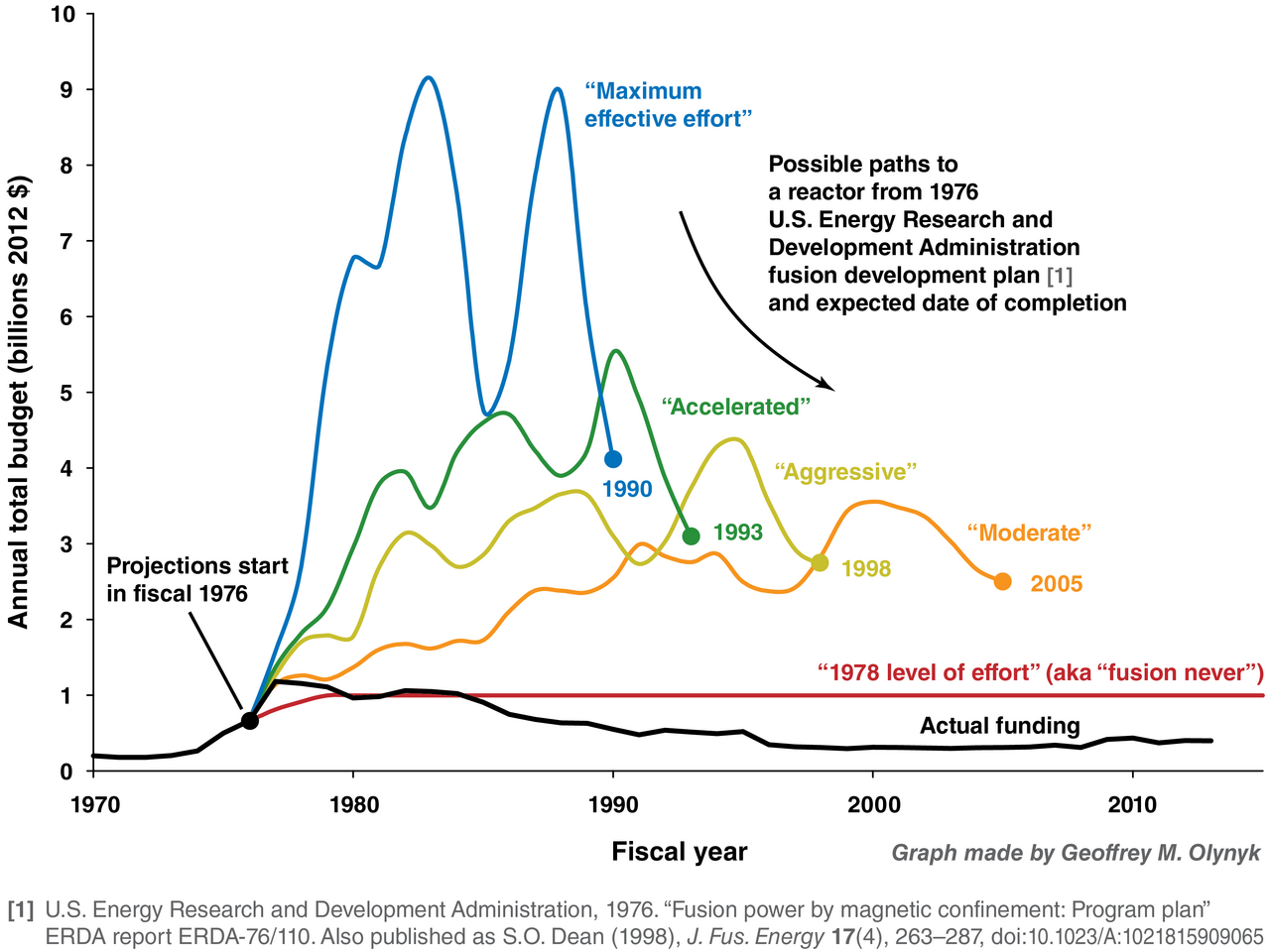There is a bit of a strawman argument going on with the nuclear energy. Here is how it usually goes down in an online community:
- There is a talk/video/discussion about challenges ahead of the renewable energy dominance.
- Someone chimes in and says nuclear has been stopped from solving all such problems, because the out of proportion fears of its risks and its waste.
- Subsequent conversations talk about how nuclear is clean, safe, and cheap -- nothing to worry about.
- Everyone involved gains a sense of accomplishment and that's where it ends.
But people like me are not worried to the slightest bit about Chernobyl and the nuclear waste. There are other reasons that nuclear fission (we'll get to fusion) may not solve all our renewable energy gaps. Namely:
- Current tech is unfeasible to build anymore both because of its construction and the scale of supply it provides.
- The next generation of plants won't be mainstream soon enough to stay hopeful for them.
- Nuclear energy cannot be delivered to critical regions of the world because of proliferation risk (atomic bomb).
- The whole climate fight is to "not leave a problem for future generations". Nuclear does come with long-term ramifications.
Based on the above, businesses should be empowered and welcome to take on nuclear ventures, provided that a full lifecycle plan is in place. But the public funding for battling climate change may not benefit from investing on nuclear any more than investing on conservation, wind, hydro, solar, and geothermal.
First let's talk about what some might "think" are the main concern of people like me:
# Not A Concern: Nuclear Waste
Nuclear energy creates a very small amount of waste. It is so small that there is only one permanent storage facility being built in the world right now. All high-level nuclear waste created worldwide is either temporary stored or dumped somewhere.
I would argue that temporary storage is actually a good thing, because:
- The nuclear waste is going to be toxic for far longer than we can make any kind of storage for it right now. 99pi has the most amazing episode about this. (opens new window)
- There are efforts to reuse this waste. Terra Power, for example, is working on burning them like a candle (opens new window).
As for the dumped waste. I am not worried about its spillage; mainly because the cat is out of the bag. The waste was handled in an absolutely cartoonish fashion during the atomic bomb era:
In July 1957, when the Navy was disposing of drums containing radioactive sodium at sea, two drums would not sink, a history [sic] of the Atomic Energy Commission says. Naval aircraft were summoned to strafe them with machine-gun fire until they sank. -NYT (opens new window)
There is so much contamination already out there; what is there to worry about? All these mishaps have turned out fine so far and there will be more of it in the future.
Nuclear spilage isn't necessarily result of a mistake. It's just a by-product of using the nuclear energy.
In the Apollo missions, a nuclear electricity generator (opens new window) was installed on the lunar modules to power scientific instruments left behind on the moon. The nuclear fuel container was designed to withstand a failed launch into orbit, but it was not designed for what happened in the Apollo 13 mission.
During Apollo 13, the command module was damaged because of an explosion, so the crew moved to the lunar module until they could orbit back to the earth. As a result, they had to return the lunar module to the earth -- with the nuclear fuel. The mission went through a course correction to discard the nuclear device (opens new window) in a location that satisfied the Atomic Energy Commission.

Some people may get effected, but it is far less than the problems we have with fossil fuels. If you have ever lived in a city where breathing becomes dangerous at times of the year, you understand this.
# Not A Concern: Nuclear Disasters
Of course we are going to talk about Chernobyl, Three Mile Island, and Fukushima. Because these have been sudden events, they are being talked about a lot. The fatality and pain these events have caused are nothing compared to the problems waste, contamination, and pollution of fossil fuels are causing. Yet, because the pollution kills slowly, it doesn't capture the breaking news headlines.
Nuclear plants are made in such a way that the continuation of the reaction is hard. If things go off track the nuclear fuel will lose its fissile state. So before Chernobyl some scientists did not think something like that can even happen (opens new window).
For the Three Mile Island, the issue was with the human interface and education (opens new window). The operators were trained on nuclear submarines. So they were taking the kind of actions that would keep a submarine safe. Those actions did not address the plant's overheating. The control room panels also did not clarify what the issue was.
In Fukushima, the problem came from a wrong regression. The trendline to find the probability of an enormous earthquake was overfitted (opens new window), so the engineers underestimated its probability. The backup power generators were at a lower terrain; they got flooded so the plant lost cooling.

Each of these problems are very unique. The causes are tangled in design, construction, and operation. There will be more of these incidents in the future, but again, that would be fine compared to the alternatives.
# Real Concerns
Now, let's talk about some real issues with nuclear technology:
- Timeline: Carbon reduction is like life savings. Start in the 20s and you will be way ahead. The conventional plants take very long to build. As for innovative ones, even with breakthroughs, most demonstrations won't probably be complete by the 30s. If we get lucky and they work, mass adoption is still decades away. Worse yet, some conservation and reduction effort may be halted now because people would think nuclear will fix it.
- Scale: Current nuclear plants are huge. While nuclear energy works well in small scales, larger designs were conventionally explored for certain safety and operational considerations. The smallest operating US Nuclear plant produces over 500MW of energy (opens new window). As a comparison, the smallest Texas dam can produce about 14MW (opens new window).
- Construction: Since the 80s there has been no conventional nuclear plant construction starts in the US. The momentum behind typifying and streamlining construction of the plants has been lost for decades. It will be nearly impossible to restart the construction of the plants cost-effectively.
- Proliferation: A nuclear power plant facilitates the production of the atomic bomb. This applies to even the "safer" types of fuel like Thorium.
- Resources: Plants using water/steam (PWR, BWR) are by far the most common types of plants. They require lots of fresh water, which can have much better uses. Also, this need limits the placement of those plants to locations with access to water. So they can be vulnerable to certain water-related natural events (e.g. tsunami).
Scale and construction remain to be the biggest showstoppers. The Bellefonte nuclear plant (opens new window) is a particular example here. Construction for 4 units started in 1975, 2 were cancelled because of unavailable demand. The other 2 are still in construction, and up for sale. As for challenges ahead of the more recent attempts, the AP1000 reactor may be revealing. (opens new window).
Then there are the CANDU Reactors: shining examples of engineering ingenuity and high safety standards. Yet when this Canadian technology was exported, India used it to make its atomic bombs. Since the early 90s, no new CANDU reactor has been built in Canada. The upfront cost of them is high both for construction and the resources (here, heavy water). While the demonstration plant was only generating 22MW, the smallest of the operational reactors is generating 500MW (opens new window). CANDU reactors are well-designed, yet they suffer from all the above problems, except for timeline.
# Possible Solution: SMRs
Small Modular Reactors.
- Solve: Scale, Construction, and Resources.
- May (Not) Solve: Timeline
- Won't Solve and will Exacerbate: Proliferation.
SMRs are currently the star of the nuclear fission show. They solve a number of issues by making a smart design alternation. In conventional reactors, the fuel is inserted into the reactor core through rods of refined nuclear fuel, but nuclear fuel is not like petroleum that burns fast and must be replenished quickly. The fuel is usable for many years and does not need to be cycled.
So what if we build the reactor core around the nuclear rods and seal the whole thing as a single unit? That way the radioactive parts are separate from the rest of the reactor and the whole unit is self-contained. It can be plugged into a power station like a giant disposable battery. After some years that the fuel is spent, the whole unit gets replaced. NuScale (opens new window) is planning to start commercializing this technology by 2025.

This modular reactors are being made small. Nuclear fuel is very underutilized in small scales. While the scale of conventional reactors was cited as a problem earlier, nuclear reactors can easily be designed for tiny amounts of energy. As mentioned, this has been successfully used in the space industry. Our farthest spacecrafts from the earth, the Voyagers, have been reliably powered for decades with nuclear generators in the harsh environment of the space.
On the downside, the smaller reactors need more enriched fuel, increasing the risk of nuclear bomb creation. So not every country can access the technology. It can mostly be deployed in China, India, and the US, which have huge demand, but won't address energy poverty. The so called "next billion" often live in countries far away from social and political stability. History has shown that the world powers do not take chances providing these nations with Plutonium.
# Possible Solution: MSRs
Molten Salt Reactors. Yes, confusingly the abbreviation is very similar to SMRs. Here I will only talk about Molten Salt Reactors when they are added to the Small Modular design.
- Solve: Scale, Construction, and Resources.
- May (Not) Solve: Proliferation
- Won't Solve: Timeline
So far when we talked about fission fuels, we only talked about rods; however, the nuclear fuel does not need to be supplemented with rods. A very clever idea is to melt the nuclear fuel in salts that can drive the fission process. This solves some problems with the rods such as cracking, it also merges the heat exchanging and the fissile mediums into one.
The current MSR designs are touted as being "walk-away safe". The molten salt loop is connected to a draining pool, but the connecting pipe is blocked by frozen matter. A freezing device keeps the frozen matter from melting. If the reactor loses electricity as a result of a disaster, before the salt can melt its container, it will thaw the frozen matter (which is not being maintained anymore). So the molten salt will drain in the pool and gradually solidify, stopping the nuclear reaction.
I must note that the picture painted regarding the MSRs is often too rosy. For example, it is said that the MSRs can use a high percent (opens new window) of the nuclear fuel. In reality, molten salt is extremely corrosive and the corrosion of the module will likely set its lifetime.
The current demonstration in Canada is set to start in 2026 (opens new window), but demonstration start is far from seeing them in stable operation. The MSRs will likely suffer from the timeline issue.
# Possible Solution: Fusion Reactors
- Solve: Scale and Proliferation.
- May (Not) Solve: Timeline, Construction, Resources
I could write a lot about fusion, but in short, achieving it will be a civilization step-up.
Fusion is what nuclear energy should have been synonymous with. All the energy we generate has originally come from fusion, because it powers the sun. The fusion energy comes from merging lighter atoms, (opens new window) which is the opposite of fusion's breaking of very heavy atoms.
The below graph shows how lighter elements produce more energy. As the elements get heavier, the release of energy reduces to the extent that making iron does not generate excess energy. With fission we release some energy stored in unstable elements. But the potential is very small compared to what Fusion can provide.

That's why hydrogen bombs are stronger than atomic bombs. In hydrogen bombs, an atomic bomb explodes around a hydrogen container to create fusion and release more energy. A hydrogen bomb does not work without a fission stage. So fusion is safe from proliferation.
We have no problem generating fusion energy, the real limitation is surplus: getting more energy than we put in smashing atoms. The surplus is achieved when the plasma created is dense and hot for an enough period of time. We exactly know how much of those will make surplus happen but most efforts are factors of 10 away from the surplus levels (see video below).
The common joke is: "fusion energy surplus is always a few years away". In reality fusion has been historically underfunded. Even when the funding is available, it is being spent too safely. ITER, the international demonstration plant to finally create a surplus, won't get there until at least 2035.

The problem is that since the start of ITER in 2007, there have been breakthroughs in superconductors that would make the construction of a new plant much simpler. ITER is in construction with older technology. So it won't fix the Scale problem too.
MIT is undertaking the most promising effort for fusion with the SPARC reactors (not to be confused with Spark). The plan to commercialize these plants is set to 2025 (opens new window). This is by all accounts extremely exciting, beyond that it's too early to say anything more.
It might be a few years old, but this video is my highly recommended summary of fusion energy generation: (opens new window).
# Summary
Conventional nuclear fission reactors are underutilized in our today's energy landscape. That said, adding more of them to the grid is challenging due to the realities of their construction demands as well as their generation scale. Small Modular Reactors solve the scale problem but have a long timeline to operation. Fusion energy may be facing the same issue. The fissile fuel alternative, Thorium, will also not solve any of the technological problems.
While the public opinion has been a barrier against nuclear energy, the above problems are all technological. There are more impactful GHG reduction measures that must be pursued first. That said, nuclear should still be an important area of energy innovation, and a Plan C in the climate fight.
Currently the most promising development appears to be MIT's SPARC.